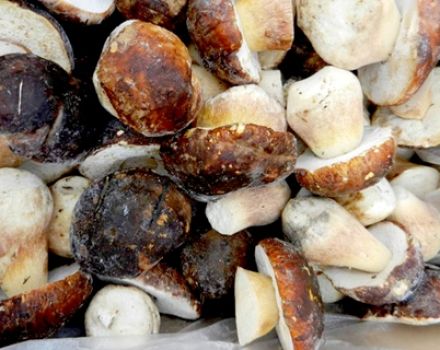Description, characteristics and history of Lily of the valley grapes, cultivation and reproduction
Until recently, a little known grape variety is becoming popular due to its positive qualities. Lily of the valley grapes have many advantages, but they are appreciated for their self-fertility and the ability to form ovaries under adverse weather conditions.
Breeding history of the variety
Ukrainian breeder V.V. Zagorulko is considered the author of this species. The first mention falls on 2012, the author himself introduced the variety. The creation of a new plant is based on two types of grapes:
- Mascot;
- Kishmish Radiant.
The resulting plants took the maximum of positive characteristics from their parents. After gardeners learned about the properties of the plant, it became especially popular.
Advantages and disadvantages
The variety has one significant drawback, it has not been studied enough. But a large number of positive qualities encourages gardeners to acquire Lily of the Valley grapes.
Pros:
- high, annual yield;
- universality of use;
- high immunity;
- tolerance of adverse weather conditions;
- taste characteristics;
- ability for long storage;
- good rooting;
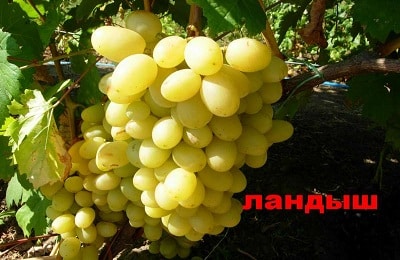
Minuses:
- the variety is poorly studied;
- exactingness to the formation;
- excessive juiciness;
- overexposed on the vine, the berries lose their taste and become mushy inside.
A gardener can personally determine the merits and demerits of a variety if he plant it on his site.
Where can lily of the valley be grown
Insufficient knowledge of the variety does not allow us to say exactly in which areas the cultivation will be favorable and in which not. Therefore, Lily of the Valley grapes are grown mainly in the southern regions. Average frost resistance allows grow grapes in the Middle lane.
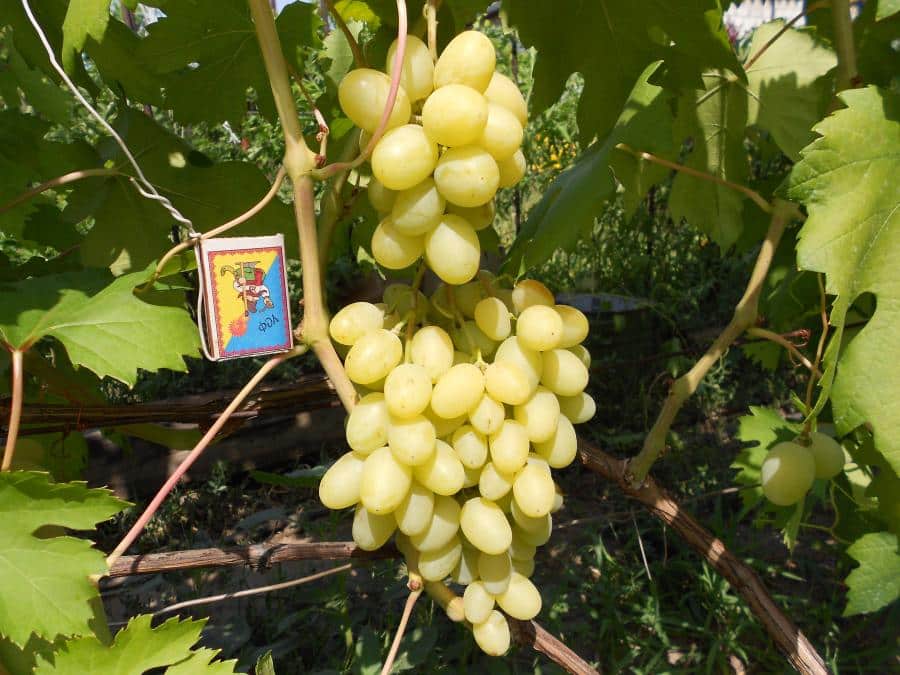
Varietal characteristics
After examining the description, the gardener makes the final decision. The selection criteria are different, therefore the varieties are in demand different. The plant is powerful, the bushes are tall. The weight of one bunch is at least 0.5 kg. The shape is elongated, cylindrical.The flowering is long and fragrant, which distinguishes the Lily of the valley from many others..
The fruits are delicious, very juicy. The mass of one berry is up to 18 g. The shade of ripe grapes is yellow.
Yield
Correct planting, care and formation of the bush determine the number of fruits obtained from one plant. Since there is no information on statistics, it is difficult to indicate the volume of the variety harvest. Researchers only collect information.
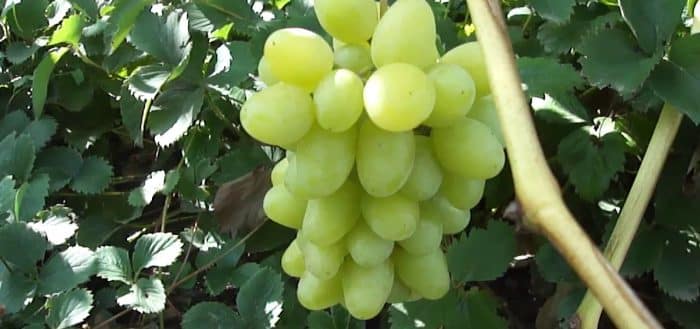
Frost resistant
Producers guarantee that the vine can withstand temperatures as low as -21 ° C. This allows you to use it as a non-covering. Or wrap up for the winter in regions with more severe climatic conditions.
Self-fertility
The flowers are bisexual, for pollination it is not necessary to plant a pollinator next to it. To increase yields, summer residents are advised to plant several different grape varieties that bloom at the same time.
Immunity to infections
Lily of the valley grapes have high immunity. Resistant to common cultural diseases. But at the same time, preventive treatment in spring and autumn is desirable. They are treated against fungal diseases before flowering and after harvest.
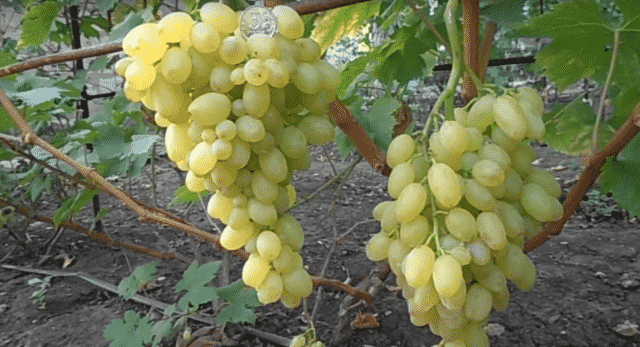
Planting a bush
For cultivation, they acquire healthy seedlings and only from trusted people. A planting pit is prepared in the fall and planted in the spring. A drainage layer must be laid on the bottom. They use broken brick or other improvised means. Then a layer of soil mixed with humus and mineral fertilizers is poured onto it.
Before planting, the seedlings are placed in "Kornevin" or another similar product for 2-3 hours.
This is necessary for better rooting. Planted on a hill or form a mound. Water abundantly and tie to a peg. Distance between plants 3 m, row spacing 5 m.
Good growing conditions
In order for grapes to grow well and develop correctly, they must be grown in favorable conditions. Lily of the valley has no requirements for soil composition. It is necessary to choose the right site in the garden.
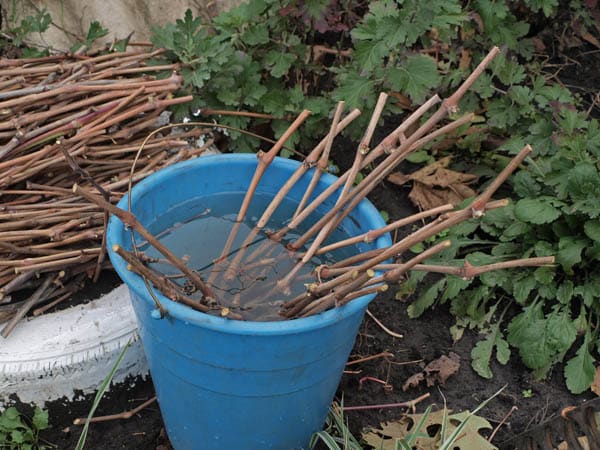
Landing place
The culture is thermophilic, this must be taken into account when choosing where to plant plants. The place should be suitable in terms of soil composition, illumination and other important parameters.
Lily of the valley has no strict preference for soil composition. But it is recommended plant grapes into fertile, breathable soil. The occurrence of groundwater should be no higher than 3-4 m.For decorating with plants, gazebos, sheds and other structures are planted.
Illumination
A light-loving plant feels better on the sunny side of the site. The longer the plants are exposed to sunlight, the richer the taste, color and aroma of the fruit. The grapes will grow in the shade, but the berries will be sour and tasteless.
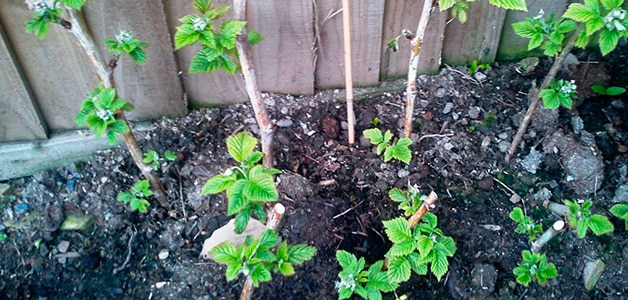
Care of young and mature vines
The yield of plants depends on proper care. Compliance with cultivation techniques will lead to its increase.
Watering
It is recommended to water regularly, in no case allowing it to dry out. But you don't need to fill it thoughtlessly. The root system of the culture suffers from decay with excess moisture.
Watering is mandatory:
- before flowering;
- after flowering;
- after harvest.

None of the grapes are watered during fruiting; excess moisture leads to cracking of the berries.
Fertilizers
Top dressing is also necessary for plants. The first 2-3 years they are not needed, the grapes are enough with what is introduced during planting. It is important to add them on time and in moderation. An excess of nutrients has the opposite effect. In the spring, organic matter is introduced, after complex mineral fertilizers. Alternating feedings will not lead to addiction.
Once every 3 years, they are fed with potassium magnesium to maintain the sugar content in the fruits.
Pruning
Pruning is done in the fall. So the grapes get sick less. Leave 10 eyes on the shoots. In order to choose the right pruning method, it is recommended to take into account the composition of the soil, the peculiarity of the variety, the location on the site, the method of cultivation.
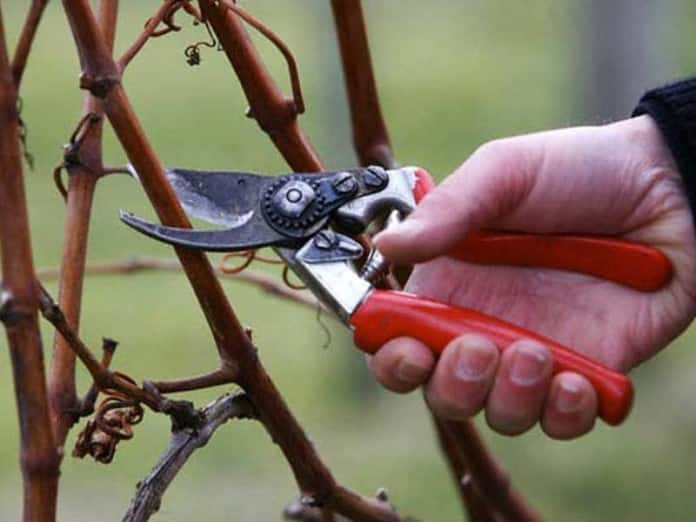
Shelter for the winter
In the southern regions, Lily of the valley is grown as a non-sheltering one, and in the northern regions it is necessarily wrapped up for the winter.For this, they use special material from a store or build a shelter on their own using straw, plant residues and a dense film, non-woven fabric and soil. If the gardener decides to plant grapes in the fall, then special attention should be paid to his shelter for the winter. A fragile plant needs high-quality shelter.
Reproduction methods
There are several ways to propagate grapes. The choice of method depends on the wishes and capabilities of the gardener.
- Cuttings. The most common way to propagate a culture. Cuttings are cut from one shoot or several, depending on how much needs to be prepared. Cut them in autumn, wrap them in a damp cloth and put them in the cellar for storage. Planted in the ground in spring. And they are waiting for the cuttings to take root and grow. Then transferred to a permanent place.
- Seed reproduction. Long-term method, the plants will bear the first fruits in the 6-7th year after planting.
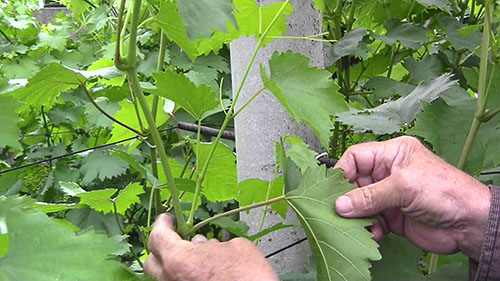
Vine bushes planted in this way do not retain their maternal characteristics.
- Vaccination. A good quality stock from a strong plant and a scion from the mother plant is required. The vaccination site must be above the ground.
- Layers. The vine shoot is instilled and watered abundantly. Allow to take root and continue to feed from the mother plant for about 2-3 months. Then you need to disconnect with garden shears and put in a permanent place.
The effectiveness of each method is different, and the result will also be different. Therefore, when choosing a method, you should weigh the pros and cons.
Diseases and pests: ways to deal with them
The variety is still poorly understood, but according to reviews, Lily of the Valley grapes are resistant to common crop diseases. Resistance to mildew and oidium is observed at 3 points. The plant also resists insect pests. But to consolidate the result, gardeners recommend processing plants. 2 preventive treatments will cope with the spread of the disease.
Traps are set against insects, since attacks are often made during fruiting. The Lily of the Valley grape was bred quite recently. But despite this, it is gaining favor and recognition among gardeners. The versatility of use, high immunity and undemanding care are gradually making it a favorite for many summer residents.








